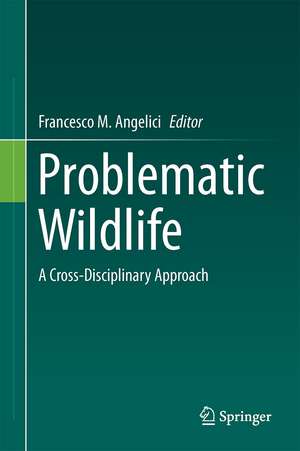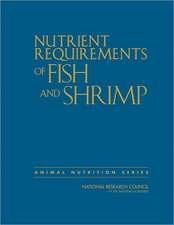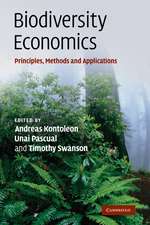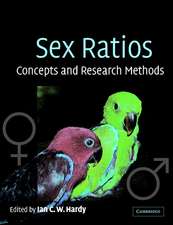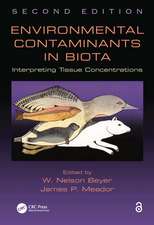Problematic Wildlife: A Cross-Disciplinary Approach
Editat de Francesco M. Angelicien Limba Engleză Hardback – 29 dec 2015
The book will be of interest to biologists, ecologists and wildlife managers involved in research on wildlife, parks, and environmental management, as well as to government departments and agencies, NGOs and conservation wildlife organizations. Even those in contact with nature, such as hunters, herders, and farmers, will be able to find a great deal of important information. Specific case studies are selected from among the most significant and prevalent cases throughout the world.
A total of 26 papers have been selected for this book, written by zoologists, biologists and ecologists. Many have an interdisciplinary approach, with contributions by economists, criminologists, technical specialists, and engineers.
| Toate formatele și edițiile | Preț | Express |
|---|---|---|
| Paperback (1) | 960.13 lei 43-57 zile | |
| Springer International Publishing – 28 mar 2019 | 960.13 lei 43-57 zile | |
| Hardback (1) | 966.45 lei 43-57 zile | |
| Springer International Publishing – 29 dec 2015 | 966.45 lei 43-57 zile |
Preț: 966.45 lei
Preț vechi: 1178.60 lei
-18% Nou
Puncte Express: 1450
Preț estimativ în valută:
184.93€ • 193.60$ • 153.02£
184.93€ • 193.60$ • 153.02£
Carte tipărită la comandă
Livrare economică 07-21 aprilie
Preluare comenzi: 021 569.72.76
Specificații
ISBN-13: 9783319222455
ISBN-10: 3319222457
Pagini: 603
Ilustrații: XVI, 603 p. 102 illus., 76 illus. in color.
Dimensiuni: 155 x 235 x 33 mm
Greutate: 1.05 kg
Ediția:1st ed. 2016
Editura: Springer International Publishing
Colecția Springer
Locul publicării:Cham, Switzerland
ISBN-10: 3319222457
Pagini: 603
Ilustrații: XVI, 603 p. 102 illus., 76 illus. in color.
Dimensiuni: 155 x 235 x 33 mm
Greutate: 1.05 kg
Ediția:1st ed. 2016
Editura: Springer International Publishing
Colecția Springer
Locul publicării:Cham, Switzerland
Public țintă
ResearchCuprins
General introduction.- Extinct species, species at risk of extinction, and declining species: some current and past case studies. Land fragmentation and habitat degradation.- When wildlife create problems for the environment and human activities: general features and some case studies.- Managing problematic species: case studies from protected areas and areas subject to other kinds of management (rural, forest, hunting and urban areas). Introductions, reintroductions and restocking.- Genetic contributions to the management of problematic species.- Species that are dangerous to humans, man-eating wildlife, etc.- Some special cases: wind farms and fauna, bird-strikes, electrocution, etc.- Bushmeat: a socio-ecological problem. The over-exploitation of wildlife for nutritional and traditional purposes. World animal trade, extinction risk and socio-economic issues.- Hidden species: an appropriate scientific approach to cryptozoology.
Recenzii
“It is devoted to a current and hot area in wildlife. … The book emerges as a keyhole for the greater door of wildlife management which can contribute to a better understanding. A book of this sort is recommended for wildlife and forestry students. It can also widen the perspective of policy makers on problematic species by paving a better way of sorting it.” (S. Suresh Ramanan and Anatoliy A. Khapugin, Nature Conservation Research, Vol. 2 (2), 2017)
Notă biografică
Francesco M. Angelici, PhD, currently works in the areas of: Biology, behavioral ecology, fauna, zoogeography, and mammal systematic and conservation studies, particularly concerning carnivores, lagomorphs and ungulates. His other fields of research are: ornithology (the biology and ecology of Falconiformes, Passeriformes and Strigiformes) and herpetology (the ecology of snakes and their trophic relationship with mammals). He studies Italian and tropical fauna, with particular reference to the conservation of vertebrates. He also works in the areas of planning and environmental conservation. In particular, he has worked in the area of wildlife management at national parks, reserves and other protected areas in Italy and abroad. He currently works as a zoologist conservationist, with hunting management agencies. He is also a specialist in African savannah environments as well as desert and tropical rain forests.
Textul de pe ultima copertă
This book provides insight into the instances in which wildlife species can create problems. Some species trigger problems for human activities, but many others need humans to save them and to continue to exist. The text addresses issues faced by economists and politicians dealing with laws involving actions undertaken to resolve the problems of the interaction between humans and wildlife. Here, the words ‘problematic species’ are used in their broadest sense, as may be appreciated in the short introductions to the various sections. At times, the authors discuss special cases while always extending the discussion into a more general and broad vision. At others, they present real cutting-edge analysis of ecological topics and issues.
The book will be of interest to biologists, ecologists and wildlife managers involved in research on wildlife, parks, and environmental management, as well as to government departments and agencies, NGOs and conservation wildlife organizations. Even those in contact with nature, such as hunters, herders, and farmers, will be able to find a great deal of important information. Specific case studies are selected from among the most significant and prevalent cases throughout the world.
A total of 26 papers have been selected for this book, written by zoologists, biologists and ecologists. Many have an interdisciplinary approach, with contributions by economists, criminologists, technical specialists, and engineers.
The book will be of interest to biologists, ecologists and wildlife managers involved in research on wildlife, parks, and environmental management, as well as to government departments and agencies, NGOs and conservation wildlife organizations. Even those in contact with nature, such as hunters, herders, and farmers, will be able to find a great deal of important information. Specific case studies are selected from among the most significant and prevalent cases throughout the world.
A total of 26 papers have been selected for this book, written by zoologists, biologists and ecologists. Many have an interdisciplinary approach, with contributions by economists, criminologists, technical specialists, and engineers.
Caracteristici
Analyzes the causes and patterns (geographic, taxonomic and trait) of the decline and extinction of terrestrial mammals Contains case studies of species suffering from various anthropogenic threats and what the reader can learn from them Provides an interdisciplinary approach to the various cases in which wildlife may be considered problematic through papers authored by ecologists, specialists in socioeconomics, zoologists, biologists and engineers Includes supplementary material: sn.pub/extras
